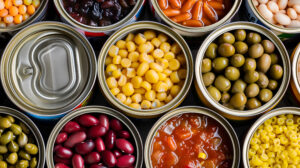Although the Recommended Dietary Allowance (RDA) for sodium is 2,300 mg a day for those 14 and older, Americans consume an average of 3,400 mg per day, with much of that intake resulting from processed foods. Because of this, the FDA has been working to reduce the amounts of sodium in food, with its newly published draft guidance on Voluntary Sodium Reduction Goals aiming to help Americans reduce average sodium intake to 2,750 mg/day. The guidance is Phase II of the agency’s three-year goal for sodium reduction in commercially processed, packaged, and prepared foods, building on the Phase I goals issued in 2021 and other previous efforts.
Understanding that sodium plays important roles in food safety and technology, the reduction to 2,750 mg/day, rather than the RDA of 2,300 mg/day, seeks to balance the new recommendation with current technical and market constraints on sodium reduction and reformulation. The FDA also recognizes that the changes will take time, thus the three-year timeline.
To set the reduction goals, FDA identified the significant contributors to U.S. sodium intake, then categorized foods based on that as well as total amount of added sodium; similarity of functional roles for sodium-containing ingredients, of sodium concentrations, and of technical potential for reduction; and compatibility with existing industry and regulatory categories. Some resulting categories were not given targets as they were not deemed to contribute meaningfully to overall sodium intake.
The draft guidance also discusses how baselines were developed for:
- Packaged foods based on label data for individual products in a category, with a focus on the foods in the top 80% of sales by volume. From this, a sales-weighted average-sodium concentration for the category was calculated, with higher sales-volume products counting for more in the final average.
- Commercially prepared foods based on public menu data of items with added sodium from the largest national and regional restaurant chains. Sales data on individual products were not available, so the sales-weighted average-sodium concentration for each category was calculated using the total sales of each chain as a proxy value, with products from chains with higher total sales of all products counting for more in the final average. Additionally, two separate baselines for packaged and restaurant (prepared) foods were calculated because sodium concentrations can vary between the two.
Although the guidance does provide specific targets, it does not provide guidance on how to achieve these, stating that “Experts from the food industry are well-positioned to innovate by exploring combinations of strategies and technologies that are most appropriate for each food category and each food product reformulation while maintaining food safety.”
The guidance stresses, however, that public health goals and nutritional quality need to be key considerations in product reformulation, noting that sodium reduction that relies on increases in added sugars would not be consistent with public health goals. Some segments of the industry are likely to have more difficulty with this than others, such as breakfast cereals, for which the added sugar and salt work together for flavor and texture. When products are reformulated to reduce sugar content, salt often needs to be added to maintain the taste of the product and vice versa.
With salt historically used as a preservative, other food segments may need to call on the cited “experts” for assistance as well. While advances in storage, packaging, and transportation have helped preservation efforts, salt is still extensively used to prevent spoilage and extend shelf life as salt can create “an inhospitable environment for pathogens, and [promote] the growth of desirable micro-organisms.” Salt can also be important for certain formulations, such as controlling the stickiness of doughs and easing the processing of some baked goods; developing desired textures in meats, cheeses, and extruded snack products; and aiding characteristics such as meltability, shredding, stretching, and flow.
In the guidance, FDA acknowledges that small businesses may have lesser resources than larger businesses for complying with the guidance, but the agency expects that given time and continuing ingredient/manufacturing innovations, all businesses will be able to achieve the goals.
While excessive sodium can be a critical health issue, a certain amount of sodium is essential to various bodily functions including that of nerves, muscles, blood pressure and volume, etc. So ensuring that a balance is maintained is essential. That said, the average consumer intake remains above the recommended U.S. levels, and well above the WHO recommended level for adults of 2000 mg/day. So anything the food industry can do to help reduce the average level will contribute to the overall health of the U.S. consumer.
Yet we also need to keep in mind that every individual is different in terms of how they handle sodium intake and the impact of sodium on their physiology and cardiovascular health. It is all about finding the correct balance for an individual, so discussing your sodium intake vs. sodium loss (such as through heavy exercise) with a health professional is a good starting point.
If you need expert help in analyzing or reformulating your products to better conform with healthy levels, give TAG a call. Our experts can help.
All content in TAG articles, newsletters, and webpages are developed and written by TAG experts, not AI. We focus on the realities and the science to bring you the most current, exacting information possible.





